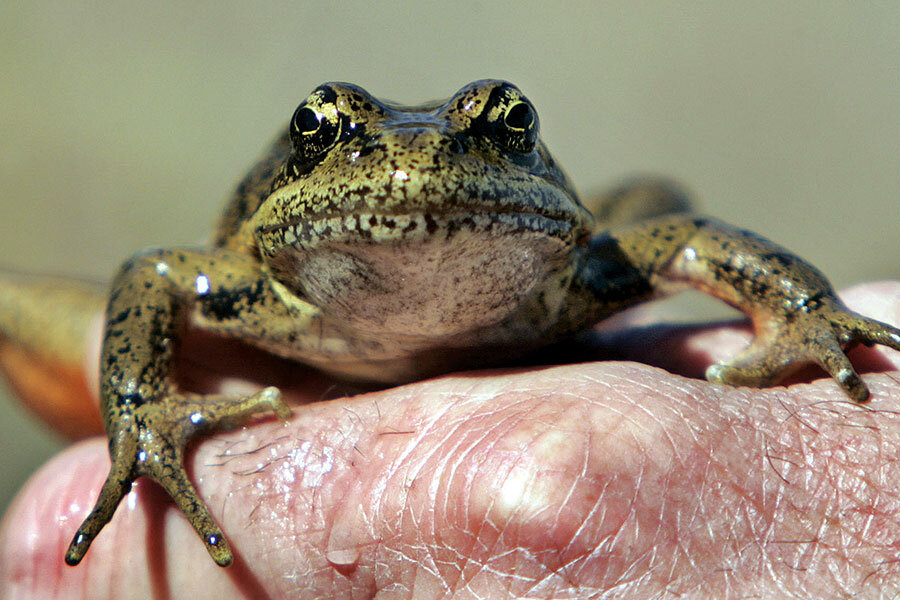Why I help frogs cross the street
Loading...
It’s a rainy January night, and I’m wrist-deep in a bucket of plump pink frogs. It feels better than money, and it is. This bucket alone can be cashed in for about 5,000 aspiring tadpoles.
I’m the newest frog wrangler in the posse, and we’re ferrying frogs across Highway 30, a four-lane gantlet north of Portland, Ore. The amphibians’ prospects are dim without our intervention. But cross they will. They’re looking for love.
As a group, we’re as modern as they come, linked by cellphone and arrayed into battalions through an interactive Web page. But when it comes right down to it – where the rubber hits the road, so to speak – the Harborton Frog Shuttle depends on a willing heart and a five-
gallon bucket. You scoop the frog off the pavement and drop it in the bucket. When the bucket gets a pleasing heft, it gets a ride across the highway.
It’s still winter, but northern red-legged frogs – listed, delicately, as a “species of concern” – get their springtime urges early. They spend much of the year up in the forested hills overlooking the Columbia River, but then they get a collective hankering for the sprawling wetlands below. Their breeding pond is in a low spot because water wants to go downhill. Frogs are basically water in a frog suit, so they go downhill, too. They’d been doing this for thousands of years before Highway 30 struck anyone as a good idea.
It’s dark and damp, but it isn’t cold. The frogs want it warm and wet. Most nights we can stay at home in our pajamas. But as soon as we get a good drizzle, and the temperature creeps toward
50 degrees F., things start hopping. A scouting crew is dispatched, and the rest of us have our boots, rain gear, and headlamps stationed by our doors.
Most of us are on the mossy side of middle age. But we nabbed our share of frogs when we were kids. These frogs don’t take much stealth to nab. When you spot one with your headlamp, it just sits there, appalled, and it’s the work of a second to fold it into your hands. Then, suddenly, the frog is all muscle and opinion, all the way to the bucket. And we’re all little boys and girls again. Soon our buckets are thumping with life – ardent, rubbery, pink, perfect life.
Harborton Drive is a major amphibian thoroughfare. The hillside funnels the frogs toward the big highway. Rob and Shawn were the first to discover their predicament, and they rounded up frog wranglers. As is so often the case, a good many already volunteer somewhere else. Several, for instance, devote one day a week to pulling a carpet of invasive ivy out of Forest Park, the very definition of a futile, endless task. But Sisyphus had a secret, and these people know it, too: The boulder gets a little smaller every time it rolls down the hill. The world is full of horror and calamity they can’t seem to do anything about. This, they can do.
Red-legged frogs are particularly charismatic. They glow in sunrise shades of rose and coral and orange – Rana aurora, the frog of dawn. The females are each hauling maybe 800 eggs, which means that last year our efforts saved about 600,000 tiny lives.
We decant them into the wetland, where chorus frogs do their utmost to drown out the traffic above, where geese complain and a great horned owl stakes out a portion of the soundscape. Where our spirits improve one little pink victory at a time. We’ve seen them safe.
But they’re going to want to go back uphill. So we come back, because we’re sorry about the bright headlamps and the buckets. We’re sorry about Highway 30. We’re sorry the wetlands are drained and paved, we’re sorry about the pesticides, we’re sorry we’ve taken over everything, and we’re very sorry about the climate.
We can’t do much about all that. But this, we can do.







